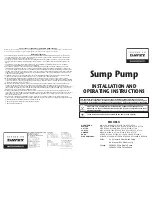
5
1.2.3 Connecting the dehumidifier water hydraulic kit
•
Attach the hydraulic kit to the wall. The water inlet and outlet pipes can be swapped around if necessary.
•
Connect the hydraulic kit to the outlet of the heat pump on the dehumidifier water circuit outlet to the dehumidifier.
•
After installation, and while filling the dehumidifier water circuit, check to make sure that the automatic bleed plugs
are loosened to bleed any air from the circuit.
: Wall mounting
: Expansion chamber
: Pressure gauge valve
: Mains water inlet (filling valve)
: Water outlet
: Heat pump Z700 DUO
: Zodiac® dehumidifier
1.3 I Power connections
• Before carrying out any work inside the appliance, it is essential to disconnect the electrical
supply as there is a risk of electric shock which can cause damage to equipment and property,
serious injury and even death.
• Only a qualified and experienced technician is authorised to carry out wiring operations inside
the appliance or to replace the power cable.
• The appliance and the dehumidifier battery heating circuit (if copper connection or other type
of metal) must be connected to an earth point.
• A poor contact can cause the terminal to overheat, and will void the warranty.
• The equipment must be used as part of an electrical installation providing 100 A per phase.
• If necessary, the installer must consult the electricity supplier and ensure that the equipment
is connected to a mains power supply with impedance below 0.44 Ohms.
1.3.1 Disconnecting the heat pump
•
The heat pump electrical supply must be provided with a protection and circuit breaking device (not supplied)
complying with the standards and regulations in force in the country in which it is installed.
•
The appliance is designed for connection to a mains power supply with TT and TN.S neutral systems.
•
Electrical protection: by circuit breaker (D curve) (for rating, see § “5.2 I Technical specifications”), with a 30 mA
dedicated residual-current protection system (circuit breaker or switch).
•
Additional protection may be required during installation to guarantee Overvoltage Category II.
•
The power supply must be compatible with the voltage indicated on the appliance information plate.
• The power cable must be insulated against any sharp or hot items that might damage or crush it.
•
The electrical connection lines must be fixed.
•
Use the cable gland to route the power cable in the appliance.
•
Use a power cable (type R2V) suitable for outdoor or below ground use and with an external diameter of between 9
and 18 mm (or run the cable inside a protective duct) .
•
We recommend burying the cable at a depth of 50 cm (85 cm under a road or path) in an electrical duct (red grooved).
•
If this below ground cable meets another cable or pipe (gas, water, etc.), there must be more than 20 cm between
them.
•
Connect the power cable to the connection terminal inside the appliance, carefully stripping the wires bare over a
length of at least 10 mm (see § “5.2 I Technical specifications”).
: earth
N: neutral
L: phase
: earth
N: neutral
L1-L2-L3: phases
Single phase terminal
Three-phase terminal







































